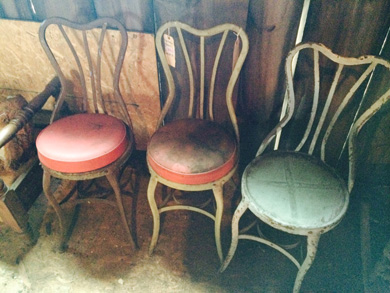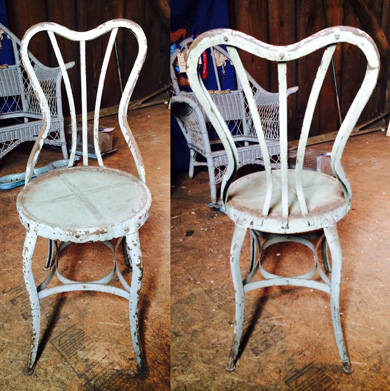 |
|
|||
 |
 |
|||
Copyright © Harry Rinker, LLC 2016 Questions
and Answers
ANSWER: The Philadelphia Athletics became part of the American League in 1900. Connie Mack, a former catcher, was named manager and purchased a 25 percent share in the club. The Athletics’ White Elephant mascot resulted from a 1902 insulting remark by New York Giants Manager John McGraw designating the Athletics as “The White Elephants.” Revenge is sweet. The Mack-led Philadelphia Athletics won the American League Pennant in 1902.
See: https://en.wikipedia.org/wiki/History_of_the_ Philadelphia_Athletics. [Author’s Aside #1 – When I was a Cub Scout, I saw my first professional baseball game, a Philadelphia Athletics game at Shibe Park. It was either 1949 or 1950. Connie Mack managed. I retain only one memory of the day. Someone pickpocketed my wallet, robbing me of the money I was given to buy a hot dog and soda.] I was not able to find another example of your pennant to confirm its date. I rely on your memory. In Philadelphia, your pennant has a value between $40.00 and $50.00. Outside of Philadelphia, its value is between $20.00 and $25.00. It will have a slightly higher value to a collector in Oakland who wants a piece of memorabilia from the historical antecedent of the present team. QUESTION: I found a set of three metal ice cream chairs in a garage. The chairs have a yoke crest, waist stiles, round seats, cabriole-style legs, and concave stretchers. They chairs are in very rough condition. A person has suggested the chairs are valuable Art Deco forms. Can you identify these chairs and tell me if the person’s assessment is true? --- BJ, Lansing, MI, Email Question
ANSWER: Readers about antiques and collectibles loves gems in the rough stories. This is one of those cases proving one understands that value in the rough is far different from value restored. When I first saw the images that accompanied the email, I questioned the ice cream parlor chair attribution. My best guess was that the chairs were part of a metal patio set, fully understanding that “ice cream chairs” often did double duty in patio sets. Historically, collecting focused on furniture and other materials found in the house. With the interest in Art Deco and Streamlined Modern design came a realization that some of the best design was found in office and industrial products. In Post-War Modernism, the home and office compete equally for collector attention. On July 22, 1902, J. F. L. Uhl received patent number 705,488 for the construction of metal furniture that featured a locked truss-rail leg assembly of cold rolled steel that withstood heavy use. This locked truss-rail leg became a standard feature on chairs designed for use by draftsmen, ice cream parlor patrons, military personnel, students, telephone operators, and others. The first Toledo Metal Furniture products featured bent plywood seats, which often splintered or separated. Eventually, the company developed a sturdy plastic seat. Toledo Metal Furniture is now a division of Banner Metal, Inc., Stroudsburg, Pennsylvania. The company still produces a revolving seat stool that evolved from a 1905 patent. See: http://industrialchicnewsnatterings.blogspot.com/2011 /06/uhl-art-steel-company-history-famous.html; http://www.apartmenttherapy.com/a-history-of-toledo- industrial-143433; and http://www.toledofurniture.com/. A fully restored “perfection soda fountain or druggists chair” is valued between $375.00 and $450.00. Presentable examples sell around $200.00. An eBay seller is offering a matched pair in very good condition for a “Buy It Now” price of $249.65. Unrestored chairs have a value around $40.00. I did find four examples on www.1stdibs.com, a website for the superrich who have no desire to comparison shop, priced at $775.00 each.
[Author’s Aside #2 – When teaching American furniture design style for the Institute for the Study of Antiques and Collectibles, I encourage participants to see “design style” where they least expect it. The Toledo “perfection soda fountain” chair is an example. The oxbow crest, styles with a central waist appearance, cabriole legs, and curved stretchers are all Queen Anne design style elements. The three central splats are not typical. Later design often takes a mix and match approach. Date does not determine design style. The fact that these chairs were made in the 1920s or 1930s does not make them Art Deco. The only Art Deco influence is the introduction of metal instead of wood.] QUESTION: I am trying to obtain a “Color by Numbers” set manufactured by Venus Paradise that includes a picture of a Voodoo woman holding a doll and sticking pins in it. The background colors were blue and black. Can you help me find one? – WS, Email Question ANSWER: Max S. Klein, owner of the Palmer Paint Company in Detroit, and Dan Robbins, a commercial artist, created Craft Master in 1950. Craft Master sold paint by number sets. Imitation is one mark of success. A Venus Paradise Pencil by Number coloring set is one example. The picture you are seeking was part of a Venus Paradise set. Your challenge is to find the name of the set that contained the picture. Once you have the set name, finding it will be easier, albeit possibly time consuming. The first step is to contact the Paint By Number Museum (www.paintbynumbermuseum.com). I checked the library to see if it contained a catalog for Venus Paradise pencil by number coloring sets. It did not. The “Help Desk” URL has a “Contact Us” button. Explain your need and ask for help. The Smithsonian Museum of American History is home to the Max Klein archives. Trey Speegle (www.treyspeegle.com) owns the O’Donoghue paint by number collection. Contact information is on his website. William L. Bird, Jr., author of “Paint by Number: How to Craze That Swept the Nation” might be able to help. Hopefully, the curator of the Smithsonian collection can provide you with Bird’s contact information. If a “Rinker on Collectibles” reader has a Venus Paradise Pencil by Number catalog or knows the set containing the picture, forward the information to harrylrinker@aol.com. This is one of those antiques and collectibles research questions that will be answered only through persistence and a great deal of luck. QUESTION: I have an unopened carton of “Election Year Special” Diamond matchbooks. I am not certain of the year. The wrapper paper of the carton contains images of George Washington, John Kennedy, Jimmy Carter, and George Bush. Does this have any collector value? – SW, Email Question ANSWER: In 1976, Diamond Match issued a presidential series featuring covers of each president. Clearly, you do not have this set because the wrapper features images of Bush and Carter. My best guess is that it dates from either the 1988 or 1992 election. Does the unopened carton have more value than the individual matchbooks inside? The asking price on eBay for a post-1980 Diamond presidential matchbook is between $2.00 and $3.00. Asking is not getting. $1.00 per matchbook is a more realistic value. As a result, a workable value for your carton is $50.00. What premium, if any, should be added for the unopened carton? Logic suggests 20 percent. Knowing the exact images on the matchbooks in the carton could change this. This knowledge can be obtained only by opening the carton. Is the risk worth it? Only you can make this decision.Harry L. Rinker welcomes questions from readers about
collectibles, those mass-produced items from the twentieth and twenty-first centuries.
Selected letters will be answered in this column.
Harry cannot provide personal answers.
Photos and other material submitted cannot be
returned.
Send your questions to: Rinker on Collectibles, 5955 Mill
Point Court SE, Kentwood, MI 49512.
You also can e-mail your questions to
harrylrinker@aol.com.
Only e-mails containing a full name and mailing address
will be considered.
You can listen
and participate in
WHATCHA GOT?, Harry’s
antiques and collectibles radio call-in show, on Sunday mornings between 8:00 AM
and 10:00 AM Eastern Time.
If you
cannot find it on a station in your area,
WHATCHA GOT?
streams live on the Internet at www.gcnlive.com.
SELL, KEEP OR TOSS?: HOW TO DOWNSIZE A HOME,
SETTLE AN ESTATE, AND APPRAISE PERSONAL PROPERTY
(House of Collectibles, an imprint of Random House Information Group, $17.99),
Harry’s latest book, is available at your favorite bookstore and via
www.harryrinker.com.
|
||||
 QUESTION: I have a 1950s-era, triangular-shaped, Philadelphia Athletics felt pennant measuring 35 inches in length and 11 inches across the top. The top has a circle containing a white elephant wearing a hat with his front legs lifted in the air. A man in a circus trainer’s uniform stands in front. “CONNIE MACK’S” is horizontal beneath the circle. “ATHLETES” continues vertically down the pennant. What is its value? – LR, Reading, PA, Email Question
QUESTION: I have a 1950s-era, triangular-shaped, Philadelphia Athletics felt pennant measuring 35 inches in length and 11 inches across the top. The top has a circle containing a white elephant wearing a hat with his front legs lifted in the air. A man in a circus trainer’s uniform stands in front. “CONNIE MACK’S” is horizontal beneath the circle. “ATHLETES” continues vertically down the pennant. What is its value? – LR, Reading, PA, Email Question In 1909, Mack purchased another 25 percent of club shares from Sam Jones and Frank Hough, Philadelphia sports writers, thus making Mack an equal partner with Ben Shibe, a minority owner of the Philadelphia Phillies. Mack coached the Philadelphia Athletics for 50 years, with two dynasties 1902-1914 and 1927-1933. The later 1930s, 1940s, and early 1950s were lean years. In the 1940s, Mack gave minority shares to his sons Connie, Jr., Earle, and Ray. In the fall of 1954, the Philadelphia Athletics were sold to Arnold Johnson and moved to Kansas City.
In 1909, Mack purchased another 25 percent of club shares from Sam Jones and Frank Hough, Philadelphia sports writers, thus making Mack an equal partner with Ben Shibe, a minority owner of the Philadelphia Phillies. Mack coached the Philadelphia Athletics for 50 years, with two dynasties 1902-1914 and 1927-1933. The later 1930s, 1940s, and early 1950s were lean years. In the 1940s, Mack gave minority shares to his sons Connie, Jr., Earle, and Ray. In the fall of 1954, the Philadelphia Athletics were sold to Arnold Johnson and moved to Kansas City.
